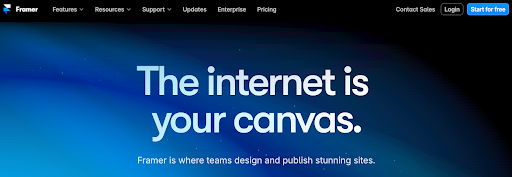The earth today is very different from the past. Processes are becoming more efficient, interactions are becoming more targeted, and designs are becoming more seamless and captivating—all subtly but gradually. These transformations are driven by growth. While many attribute it solely to technological advancement, it is also the result of fundamental growth—a shift in our thinking and comprehension. Within this context, Web Design 3.0 stands out as a pivotal development.
Web Design 3.0 marks a significant evolution in how we create and experience websites. The era of static pages and generic layouts is over. Today, we are entering a world where Web 3.0 technologies converge to deliver an impeccable online experience. Read on as we broaden your horizons and explore the transformative impact of Web Design 3.0.
Understanding Web Design 3.0
This latest advancement in website development, known as Web Design 3.0, places a strong emphasis on providing tailored, dynamic, and user-driven browsing experiences. Cross platform integration, augmented reality (AR), and virtual reality (VR) characteristics have been incorporated into the web design 3.0 concept to make websites more user-friendly and responsive to individual demands.
Key Features of Web Design 3.0
Personalisation
Web Design 3.0 utilizes Artificial Intelligence (AI) and machine learning to assess user actions and interests. This implies that with Web design 3.0, websites have the capability to adjust in order to offer content customized for individual users.
Interactivity
Websites created using Web Design 3.0 are extremely engaging. They respond instantly to user input and often incorporate features like voice assistants to help with site navigation, chatbots for rapid answers, and 3D visuals for a more engaging and dynamic online experience.
Immersive Experiences
By incorporating AR and VR, Web Design 3.0 offers experiences that go beyond simple online browsing. As an illustration, consider being able to walk through a home you are thinking about purchasing virtually, or virtually access fittings for your room to make sure it fits before making a purchase.
Conveniency
Web Design 3.0 emphasizes the importance of mobile-friendly design as a greater proportion of users access the web via mobile devices. This simply means that websites can be designed to work seamlessly across all platforms, including desktops, iPads, and mobile devices, guaranteeing a consistent and enjoyable user experience.
Enhanced Performance and Speed
User satisfaction relies heavily on speed and performance. Web Design 3.0 employs innovative coding methods and efficient frameworks to make sure websites load fast and operate smoothly, decreasing the likelihood of users abandoning the site because of slow loading times.
Security and Privacy
Due to increasing worries regarding data privacy, Web Design 3.0 prioritizes secure design techniques. Websites are constructed with strong security features to safeguard user information and adhere to privacy laws, ensuring users feel secure when engaging with a website.
How It Differs from Previous Generations
Web Design 1.0
During this initial phase of web development, websites primarily consisted of static HTML pages that lacked interactive elements. Most websites were focused on providing information and did not customize to user preferences or input.
Web Design 2.0
We also refer to this period as the social media age. Thanks to technologies like CSS and JavaScript, people were able to either create their own content or consume pre-existing content on the website .
Web Design 3.0
As the expression goes, third time’s the charm. Expanding upon the principles of Web Design 2.0, the third iteration introduces enhanced customisation, live interaction, and immersive features such as augmented reality and virtual reality. The main emphasis is on developing a tailored and interactive user experience.
In essence, Web Design 3.0 involves developing intelligent, engaging, and customised online experiences that adjust according to the preferences and requirements of each user. It represents a notable advancement from earlier iterations, incorporating fresh technologies to enhance the interactivity, effectiveness, and safety of websites.
Renowned establishments that use Web design 3.0
- Based on a consumer’s viewing preferences and behaviors, Netflix use AI to recommend films and TV series. Web design 3.0 eables the platform to be user-friendly and responsive, providing a seamless viewing experience.
- Facebook provides a unique user experience through personalised news feeds and dynamic content, powered by intricate algorithms. The interactive elements of the platform, such as reactions and comments, help encourage user engagement.
- Sephora uses AR technology for users to virtually test makeup products on their website and app. This immersive experience is a key feature of Web Design 3.0, improving user engagement and contentment.
- Tesla’s website offers users an engaging experience through interactive features and real-time updates. Tesla’s website showcases innovative web design by offering the ability to customise car models and explore features via AR technology.
- Nike’s website engages customers with customised product suggestions and engaging content. An immersive shopping experience is offered via the site’s interactive design elements,powered by web design 3.0 features, which include 3D renderings of the products.
Web Design 3.0 tools
There are various Web Design 3.0 tools available for developers and product designers alike. All you have to do is choose what aligns with your needs. A few are shown below;n experienced web designer without having a strong grasp of this tool. Figma is completely available for use at no cost. It was designed for the web, but also offers a desktop app. The user experience is seamless and effortless, with no added complexity. Every button and function is designed to facilitate the creation of personalised designs. The integration of Figma’s tool with different plugins and application plugin interface (APIs) enhances its functionality, making it a flexible tool for Web 3.0 projects.
Framer

Framer is also a tool in this same category. Framer is a tool that supports cross platform collaboration and merges design and code into one tool, enabling designers to craft interactive prototypes with sophisticated animations and interactions.
Sketch

Sketch is a distinctive top design software for Mac OS. What makes Sketch incredibly popular and in high demand is its comprehensive features for digital design, such as website and mobile app design, prototyping, and additional functionality through plugins. Its emphasis on adaptive design guarantees that websites appear visually appealing on any device, a crucial element of Web 3.0 design.

